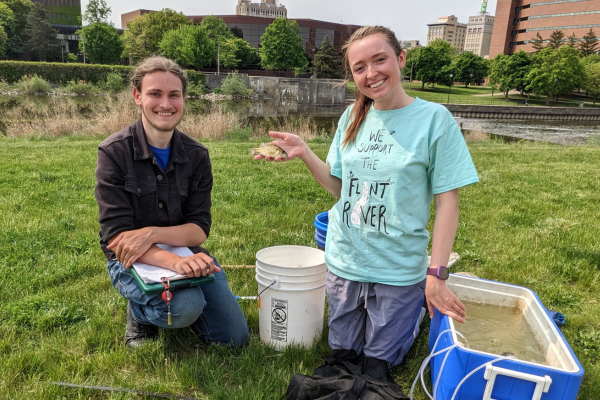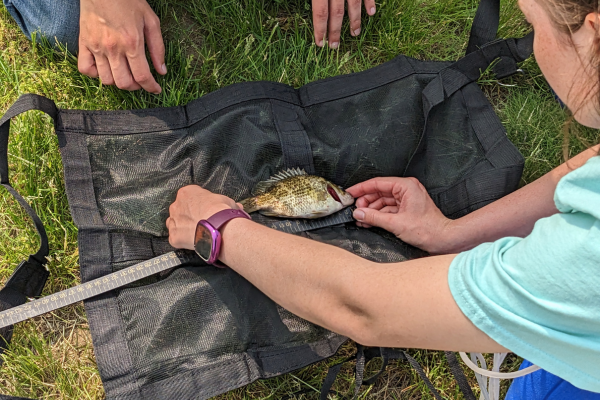UM-Flint biology students track Flint River restoration efforts

If you ever walk by the portion of the Flint River that runs through the University of Michigan-Flint's downtown campus, you may run into an interesting sight – a large group of UM-Flint biology students in waders, searching for fish. And chances are, Arianna Elkins will be among them.
Elkins, a joint BS/MS Wildlife Biology student living in Flint, is participating in a research project on the effects of a $38 million restoration project involving the Flint River. Elkins started her studies at UM-Flint with engineering, but switched to biology early on, realizing that she preferred the science and practical research involved more than her initial degree.
"I realized that I liked to see the immediate practical effects of this kind of research," Elkins said. "Doing active observations in the field is really interesting – it's so cool to see the kinds of wildlife that are right here at your feet."
Elkins and her fellow students are often down by the river early in the morning, outfitted to search for fish and take samples of both fish, the water, and the sediment at the bottom of the river. Their goal is to observe and measure the progress being made in remediating the damage done to the river by historical industrial pollution and urbanization. To do this, Elkins and her classmates catch sample fish for several hours a day, measuring them, weighing them, noting any damages or disease, tagging them, and then releasing their subjects back into the river.
"Tagging fish allows us the opportunity to identify an individual if the fish is caught again. this allows us to then see how healthy the fish are," said Elkins. "We also look for any types of sickness or injuries that may be caused by pollution. We mark that down, the date we saw it, and what kind of fish it is."
While most of the organisms they catch are expected, students were pleased to find a few surprises, one of them being just how many different species there are.
"We've caught 35 different species of fish so far, and the number keeps growing," Elkins said. "That's a good sign – we try to track the fish's movements, to see what areas of the river they are inhabiting."

The students' main method of retrieval is cast-netting, in which a large net is thrown into the water, allowing multiple samples to be caught at once. The students measure water quality by taking water samples and monitoring water metrics and the presence of chemicals. They dredge the bottom to understand what substrate, and therefore what habitat, the fish have available to them near the study site.
Elkins once caught a fish that had anchor worm parasites stuck under its scales. She and other students spent their time removing the parasites before attaching a tag to the fish's tail, trying to ensure it would be as healthy as possible before releasing it back into the river. Should an angler catch a fish already tagged by the class, the fishermen can contact the DNR with the tag ID number listed on their tag, and the DNR then relays it to the students. Typically the fishermen also record the tag ID number, the species of the fish, its length, weight, location, and if the fisherman returned it to the river or not. Elkins and her fellow students always return the fish to the water after taking their measurements.

"I like being able to study wildlife without harm," Elkins said. "It's good to focus not on trying to save the whole world, but just a little piece of it."
While they may not be involved in the actual restoration efforts themselves, the data is useful to the experts and scientists currently conducting restoration projects. One group working to improve the local waterway is the Flint River Restoration Project, with UM-Flint students staying informed of their efforts. Elkins emphasized the importance of the different groups working to restore the river.
"Everyone is trying to make the river as healthy as possible. It's really important that we all work together, and the different groups keep each other updated. Tracking this ecological progress is a good way to keep up with that."
More information about UM-Flint's Flint River study can be found online. You can also learn more about the MS in Biology on the program's webpage.
Related Posts
No related photos.
Rowan Borninski
Rowan Borninski is the recruiting and marketing specialist for the Office of Graduate Programs. She can be reached at rosubo@umich.edu.